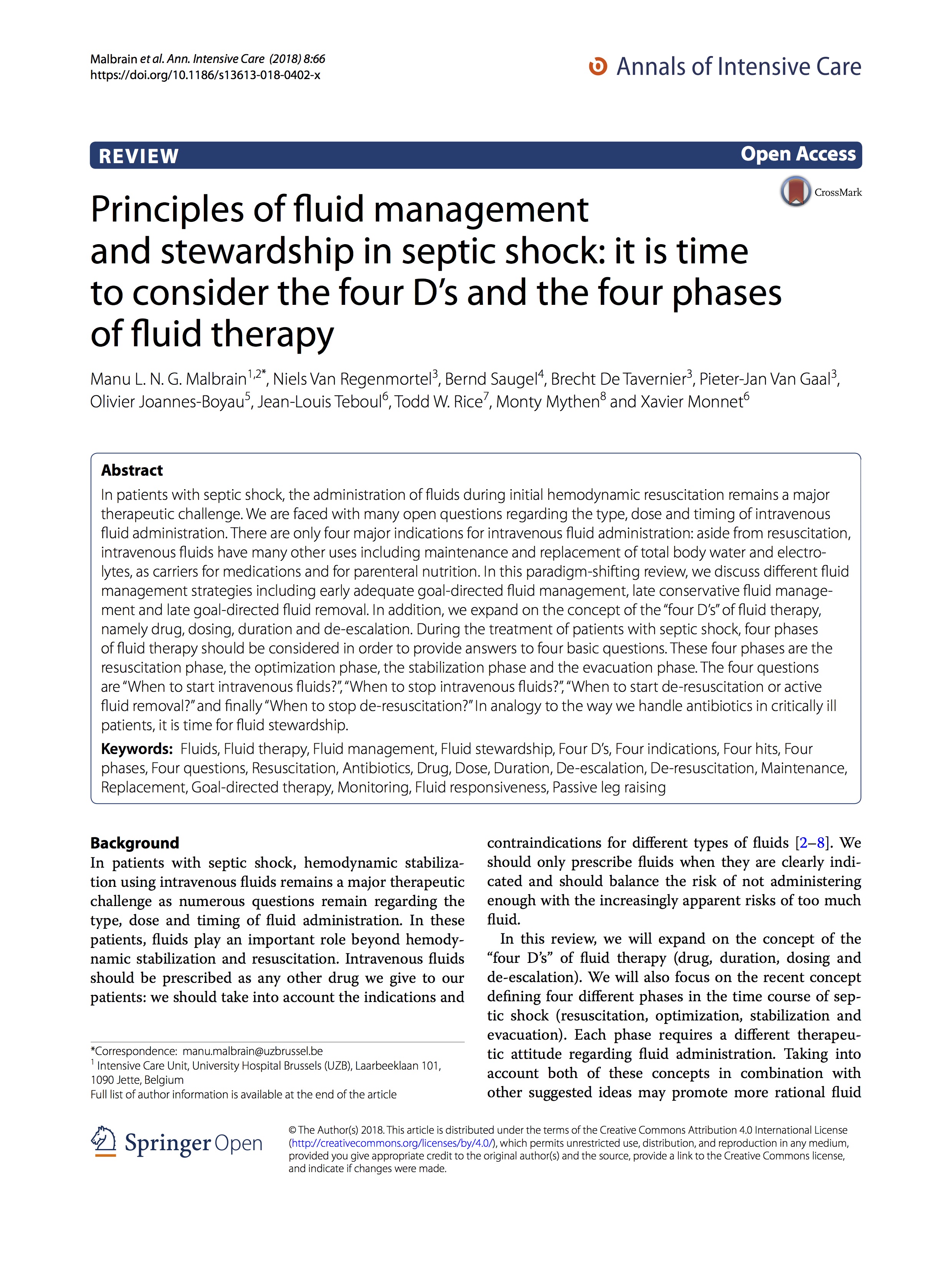iFA Endorsed Research: Fluid Stewardship

Principles of fluid management and stewardship in septic shock: It is time to consider the four D’s and the four phases of fluid therapy
- Manu LNG Malbrain, MD, PhD (This email address is being protected from spambots. You need JavaScript enabled to view it.)
- Niels Van Regenmortel, MD (This email address is being protected from spambots. You need JavaScript enabled to view it.)
- Bernd Saugel, MD, PhD (This email address is being protected from spambots. You need JavaScript enabled to view it.)
- Brecht De Tavernier, MD (This email address is being protected from spambots. You need JavaScript enabled to view it.)
- Pieter-Jan Van Gaal, MD (This email address is being protected from spambots. You need JavaScript enabled to view it.)
- Olivier Joannes-Boyau, MD (This email address is being protected from spambots. You need JavaScript enabled to view it.)
- Jean-Louis Teboul, MD, PhD (This email address is being protected from spambots. You need JavaScript enabled to view it.)
- Todd W. Rice, MD, MSc (This email address is being protected from spambots. You need JavaScript enabled to view it.)
- Monty Mythen, MBBS, MD (This email address is being protected from spambots. You need JavaScript enabled to view it.)
- Xavier Monnet, MD, PhD (This email address is being protected from spambots. You need JavaScript enabled to view it.)
First Online: 22 May 2018
DOI: 10.1186/s13613-018-0402-x
Cite this article as: Malbrain, M.L.N.G., Van Regenmortel, N., Saugel, B. et al. Ann. Intensive Care (2018) 8: 66. https://doi.org/10.1186/s13613-018-0402-x
Download PDF: https://link.springer.com/content/pdf/10.1186%2Fs13613-018-0402-x.pdf
Abstract
In patients with septic shock, the administration of fluids during initial hemodynamic resuscitation remains a major therapeutic challenge. We are faced with many open questions regarding the type, dose, and timing of intravenous fluid administration. There are only four major indications for intravenous fluid administration: aside from resuscitation, intravenous fluids have many other uses including maintenance and replacement of total body water and electrolytes, as carriers for medications, and for parenteral nutrition. In this paradigm-shifting review, we discuss different fluid management strategies including early adequate goal-directed fluid management, late conservative fluid management, and late goal-directed fluid removal. In addition, we expand on the concept of the "four D’s" of fluid therapy, namely drug, dosing, duration, and de-escalation. During the treatment of patients with septic shock, four phases of fluid therapy should be considered in order to provide answers to four basic questions. These four phases are the resuscitation phase, the optimization phase, the stabilization phase, and the evacuation phase. The four questions are “When to start intravenous fluids?”, “When to stop intravenous fluids?”, “When to start de-resuscitation or active fluid removal?” and finally “When to stop de-resuscitation?”. In analogy to the way we handle antibiotics in critically ill patients, it is time for fluid stewardship.
iFA Unrestricted Educational Grant
The costs covering the open access publication of this review article were covered by an unrestricted educational grant from the International Fluid Academy (IFA). The IFA is integrated within the not-for-profit charitable organization iMERiT (International Medical Education and Research Initiative) under Belgian Law. The IFA website (http://www.fluidacademy.org) is now an official SMACC (Social Media and Critical Care) affiliated site and its content is based on the philosophy of FOAM (Free Open Access Medical Education - #FOAMed).
Picture courtesy: iSTOCK PHOTO
